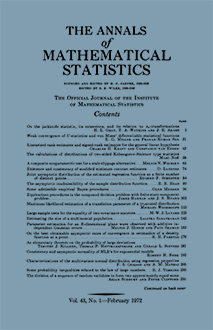Abstract
The history of fiducial probability dates back over thirty years and so is long by statistical standards; however thirty years have not proved long enough for agreement to be reached among statisticians as to the derivation, manipulation or interpretation of fiducial probability. The reason for this lack of agreement and the resulting controversy is possibly due to the fact that the fiducial method has been put forward as a general logical principle, but yet has been illustrated mainly by means of particular examples rather than broad requirements. This paper explores in two respects certain natural general requirements for the application of the fiducial argument in the bivariate case that have been proposed. An essential step in the process of fiducial inference is the derivation of the fiducial distribution. Properties that have been emphasized by Fisher in order that a genuine fiducial distribution may be obtained include sufficiency, the absence of any a priori information and the existence of a pivotal quantity. About ten years ago examples were discovered demonstrating that the distribution induced by a pivotal, sufficient and smoothly invertible set of quantities is not necessarily unique; that is to say the induced distribution depends on the particular set of pivotal quantities chosen (see [50]). the pivotal quantities used in these examples were denounced as having been "artificially constructed" (see [15]), and additional requirements were proposed. In the bivariate case requirements reduced to either $f(x, y \mid \alpha, \beta) = f(x, \alpha)f(y \mid x, \alpha, \beta)$, or $\alpha, \beta) = f(x, \alpha, \beta)f(y \mid x, \beta),$ $f(x, y \mid \alpha, \beta)$ being the given density. However as will be seen in this paper, neither of these requirements is sufficient to ensure the uniqueness of the resulting distribution. It may be argued (see [11]) that non-uniqueness of the induced distribution is no handicap. It is, however, more than intuitively appealing to feel that if one starts with a problem perfectly symmetrical in the parameters and the random variables, as the examples presented are, then the answer should be perfectly symmetrical as well. Recently Lindley proved a theorem in the one-dimensional case to the effect that a fiducial distribution is Bayes' posteriori if and only if the c.d.f. is invariant under a continuous one-parameter group of transformations. It is natural to seek an extension of this theorem to the multi-parameter case, for if it can be shown that there is a group of a certain form, then there exists an essentially unique pivotal, a frequency interpretation and certain consistency properties (see [21]). It is known in the multi-parameter case that if the c.d.f. is invariant under a particular type of group, then the fiducial distribution is Bayes' posteriori. However the final example presented in this paper demonstrates that a bivariate fiducial distribution may be Bayes' posteriori without possessing strong group invariance properties.
Citation
David R. Brillinger. "Examples Bearing on the Definition of Fiducial Probability with a Bibliography." Ann. Math. Statist. 33 (4) 1349 - 1355, December, 1962. https://doi.org/10.1214/aoms/1177704367
Information





